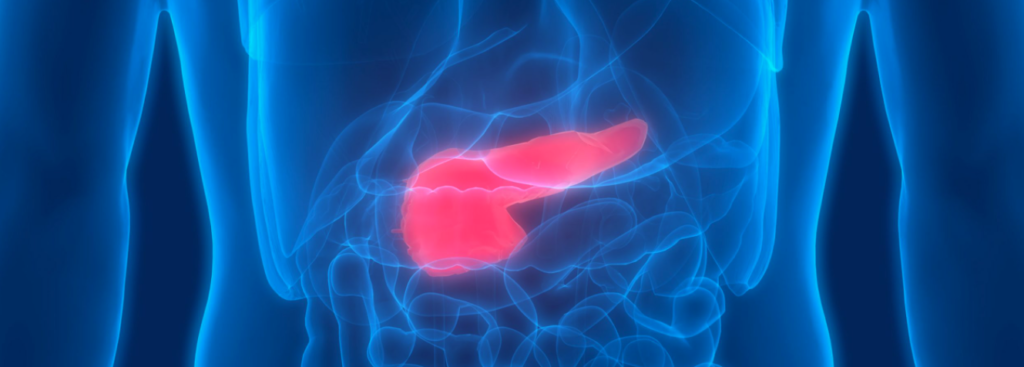
Two types of cancer are frequently seen.
In this informative text, information will be given about pancreatic ductal adenocarcinoma, which is frequently seen.
Most people with pancreatic cancer experience pain and weight loss, with or without jaundice (yellowing of the skin):
If you develop symptoms that raise the suspicion of pancreatic cancer, your doctor or nurse will order one or more tests. These may include blood tests and imaging tests such as ultrasound or computed tomography (CT) scan, and/or an endoscopic test called endoscopic retrograde cholangiopancreatography (ERCP). These tests can show if there is a mass (growth) in the pancreas and whether surgery is possible to remove the mass. Biopsy — In some cases, your doctor will recommend a biopsy to confirm the diagnosis of cancer. To perform a biopsy, the doctor will use a CT scan or ultrasound to pinpoint the mass, then take a tissue sample from the mass with a needle. A biopsy may also be taken using a different endoscopic procedure called ERCP or endoscopic ultrasound (EUS). A biopsy involves removing a small piece of tissue from the mass. The pieces taken by the Pathology Doctor are examined under a microscope.
Stages of pancreatic cancer range from stage I, which is the earliest stage, to stage IV. In general, low-stage cancers are more likely to be successfully treated than high-stage cancers. In staging; Information may be given as surgically resectable cancer (stages I and II), locally advanced cancer (stage III), or metastatic cancer (stage IV). Each phase is also evaluated within itself.
Today, chemotherapy can be used with or without radiation therapy to initially shrink the tumor and increase the chance of it becoming resectable for locally advanced cases that are in between these stages and need to be decided by the councils.
Laparoscopy — Some centers recommend a laparoscopy before attempting to surgically remove the cancer to learn more about the location and extent of the cancer. Laparoscopy is the examination of the inside of the abdomen with a camera to examine the organs in the abdomen under general anesthesia.
Pancreatic cancer can be treated with several approaches. The earliest stage pancreatic cancers can usually be treated with surgery and a cure can be achieved. After surgery, further treatment, often called “adjuvant therapy”, is recommended. This may include chemotherapy and radiation therapy.
However, pancreatic cancer is at its earliest stage in very few patients. While surgery is recommended in this patient group, chemotherapy and/or radiation therapy may be administered first in non-early stages in order to “downgrade” and improve outcomes from surgery. This is called neoadjuvant therapy and the patient is reassessed during the course of treatment. Surgery can be rescheduled in patient groups with regression.
In other cases, surgery is not possible; Pancreatic cancer usually progresses by the time it is diagnosed. If surgery is not possible, radiation therapy, chemotherapy, or both are often used to shrink the cancer, reduce symptoms, and prolong life.
The standard operation for tumors in the head of the pancreas is a Whipple procedure (also called a pancreaticoduodenectomy).
In this procedure, the surgeon removes the head of the pancreas, duodenum (first part of the small intestine), part of the jejunum (the next part of the small intestine), common bile duct, gallbladder, and part of the stomach.
In addition, Pyloric Protective Whipple Surgery, in which the last part of the stomach is preserved, is also applied in appropriate cases.
Surgery for tumors in the body or tail of the pancreas, called “Distal or subtotal pancreatectomy”, is the surgery in which the head of the pancreas is preserved and the remaining body is removed together with the mass. In these surgeries, the spleen is usually included in the surgery because the vessels of the spleen are inside the operating area and the area that needs to be removed. Since tumors in the body or tail of the pancreas do not cause the same symptoms as those in the head of the pancreas, these cancers may appear in more advanced stages.
Laparoscopy may be needed to make sure the cancer has not spread inside the abdomen.
Adjuvant therapy after surgery refers to chemotherapy, radiation, or a combination of both. Adjuvant therapy is recommended for people considered to be at high risk for the cancer to come back (called a recurrence) after a tumor has been surgically removed.
Even if the tumor is completely removed, small cancer cells may remain in the body and grow, causing a recurrence after surgery. Adjuvant therapy can prolong survival by removing small cancer cells before they have a chance to grow.
People with completely removed pancreatic cancer receive adjuvant therapy after surgery. Chemotherapy alone or a combination of chemotherapy and radiation therapy (this strategy is called “chemoradiotherapy”) is applied, especially in patients at high risk of relapse, with the decision of oncology committees.